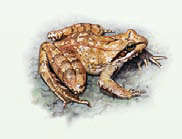This amphibian is an Italian endemism. It prefers the hilly and mountain areas where it reproduces in the streams and creeks (which generally flow within wooded areas) or in the tanks and troughs. It’s present only sporadically in ponds or temporary pools. The activity is largely diurnal. The peculiarity of the species is to remain linked to the aquatic environments also outside the reproductive period.
The maximum length of the body is 6 cm in males and 6,5 in females. The upper parts of the Apennine frog have colors ranging from brown-reddish, to brown, to gray, to gray-olive, to brown-yellowish; as a rule they have various darker or even whitish, ochre-golden or pinkish spots. The lower parts are whitish, with the throat and a part of the chest more or less stained with dark. It has a quite evident temporal band. The male is recognized by the female for the more robust forearms and a gray-blackish bearing on the first finger of the fore leg.
This frog reaches sexual maturity at the age of 2-3 years. The sexual intercourse can last even some hours. The male makes his voice heard in competitions with other specimens for the possession of the female. The female lays from 100 to 500 eggs gathered in roundish masses that adhere to the submerged stones or rest on the bottom. The development of the larvae takes about 2-3 months; these are brown-greyish and at the end of development they reach 4-5,5 cm of total length.
The adults nourish of small invertebrates whilst the larvae are omnivorous (mainly vegetarian).
The main threats for the species are the loss of habitats due to water catchment works and the elimination of the shore vegetation, the pollution of the waters and the introduction of trout into the streams. The latter can decimate larvae, neometamorphoses and young frogs. The Apennine frog is included in Annex II of the Bern Convention and in Annex D of the Habitats Directive.

